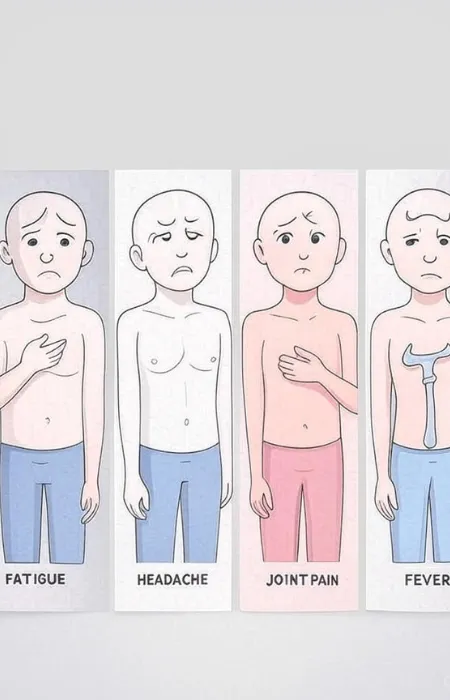Lyme Disease Treatment
Lyme Disease Treatment at Apex Chiropractic & Wellness Center in Lancaster, PA

If you are searching for Lyme disease treatment in Lancaster, PA, Apex Chiropractic & Wellness Center offers care designed to address the underlying causes of this complex condition. Lyme disease can affect multiple systems in the body, and patients often experience long-lasting symptoms that are not always resolved through conventional hospital care. Our clinic takes a holistic, patient-focused approach that blends advanced diagnostics, targeted therapies, and ongoing wellness support to restore health and vitality.
By focusing on both the physical and biochemical impacts of Lyme disease, we help patients move beyond symptom management and toward lasting recovery. Residents of Lancaster and surrounding areas in Pennsylvania can trust our team to provide personalized evaluations, innovative treatment options, and clear guidance on reducing the risks of future tick-borne infections.
At Apex Chiropractic & Wellness Center, our goal is to uncover the root issues driving inflammation and discomfort while empowering patients with the knowledge and tools they need to reclaim their well-being. Whether you are newly diagnosed or have been struggling with persistent symptoms, our team is here to deliver compassionate care tailored to your needs.
Understanding Lyme Disease and Tick Borne Illnesses in Pennsylvania
Lyme disease remains a pressing health concern in Pennsylvania, and Lancaster residents face an elevated risk due to the region’s woodlands, fields, and humid climate. These environments provide ideal conditions for ticks that spread Borrelia burgdorferi, the bacteria responsible for Lyme disease. Because everyday activities like hiking, gardening, or even walking pets can lead to tick exposure, it is important to understand how infections occur and what symptoms to watch for.
Tick borne illnesses extend beyond Lyme disease, and infections such as babesiosis or anaplasmosis can create overlapping symptoms, including fever, fatigue, and muscle aches. This similarity makes it difficult for patients to know the cause of their discomfort without professional support. That is why Apex Chiropractic & Wellness Center emphasizes early evaluation and comprehensive health assessments. Our services are designed not only to detect signs of infection but also to uncover how tick exposure may already be impacting the nervous system, joints, and overall well-being.
Preventive steps like wearing protective clothing, using tick repellents, and conducting regular tick checks remain essential. Yet prevention alone is not enough. Even careful individuals may still encounter ticks in Lancaster’s parks and backyards. When that happens, Apex provides resources and personalized care to guide patients from early detection through long-term recovery. We combine patient education with advanced diagnostics so individuals can feel confident about their next steps in treatment.
By linking awareness with practical care options, our team helps Lancaster residents stay proactive. Understanding Lyme disease and other tick borne illnesses is the foundation, but taking action with the right support is what ensures lasting health.
Common Symptoms and Early Warning Signs

Common Symptoms and Early Warning Signs
One of the challenges with Lyme disease is that its early symptoms often resemble other common illnesses. Patients may dismiss the signs as minor or unrelated, delaying treatment and increasing the risk of long-term complications. Recognizing the early warning signs is essential for residents of Lancaster, PA, especially after time spent outdoors where tick exposure is possible.
Early symptoms may include:
Flu-like fatigue that does not improve with rest
Headaches or neck stiffness
Fever, chills, or sweats
Aching muscles and joints
Swollen lymph nodes
Rash, which may or may not resemble the “bull’s-eye” pattern
It’s important to remember that not every case of Lyme disease presents with a visible rash. In fact, many patients never notice one. Instead, subtle symptoms such as recurring fatigue or unexplained joint pain can serve as early indicators that something is wrong.
If left untreated, Lyme disease may progress to more advanced stages, causing:
Chronic joint inflammation and stiffness
Neurological issues, including memory problems and difficulty concentrating
Nerve pain or tingling in the arms and legs
Persistent headaches and balance problems
At Apex Chiropractic & Wellness Center, our providers take these warning signs seriously. We use advanced testing methods combined with thorough health evaluations to identify whether symptoms are linked to a tick borne illness. By addressing potential Lyme disease early, we help patients avoid the frustration of prolonged discomfort and support their recovery before symptoms escalate.
The Importance of Early Detection and Diagnosis in Lancaster PA
Early detection is one of the most important steps in managing Lyme disease effectively. The sooner an infection is identified, the better the chances of reducing inflammation, preventing long-term complications, and restoring overall health. In Pennsylvania, where tick exposure is common, many patients overlook the subtle signs or wait until symptoms worsen before seeking care. This delay often allows the bacteria to spread, making treatment more challenging.
At Apex Chiropractic & Wellness Center, we emphasize the value of timely evaluation. Our team provides advanced diagnostic services that go beyond traditional lab work. While standard hospital testing can sometimes miss early infections, our clinic combines specialized assessments with a detailed review of patient history and current symptoms. This approach helps us identify whether a recent tick bite or unexplained illness may be linked to Lyme disease.
Why early detection matters:
Prevents chronic joint pain and inflammation from developing
Reduces the risk of neurological complications such as memory loss or nerve pain
Improves the effectiveness of targeted therapies
Shortens recovery time and minimizes the chance of relapse
For Lancaster residents, acting quickly after noticing possible symptoms or recalling a recent tick bite can make a significant difference. Apex Chiropractic & Wellness Center provides accessible, patient-centered diagnostic options designed to give individuals clarity and confidence about their health. By identifying Lyme disease in its earliest stages, we help patients take the right steps toward recovery and reduce the likelihood of long-term disruption to their lives.
Advanced Testing and Nervous System Assessments at Apex
When it comes to Lyme disease, accurate diagnosis requires more than a basic blood test. Many patients in Lancaster, PA find themselves frustrated when standard hospital evaluations fail to capture the full scope of their condition. At Apex Chiropractic & Wellness Center, we believe in a more complete approach, one that combines advanced testing with in-depth assessments of the body’s neurological and musculoskeletal systems.
Our advanced testing includes:
Comprehensive laboratory screenings for tick borne infections
Nervous system evaluations to detect changes in reflexes, coordination, and nerve signaling
Musculoskeletal assessments that reveal postural imbalances and joint dysfunctions often overlooked in traditional care
Functional health screenings to uncover hidden biochemical or inflammatory markers
This multi-layered process allows us to see how Lyme disease is affecting each patient individually. For example, neurological testing may reveal subtle issues with balance or memory before they become major concerns. Similarly, musculoskeletal evaluations often highlight how inflammation from Lyme disease is altering movement patterns and creating chronic pain.
Unlike generalized hospital protocols, our testing is designed with Lyme disease in mind. By combining modern technology with hands-on analysis, we can identify the underlying disruptions caused by tick borne illness and create a targeted plan for recovery. Patients consistently share that this detailed approach not only provides clearer answers but also relieves the uncertainty that comes from vague or inconclusive test results.
At Apex Chiropractic & Wellness Center, advanced diagnostics form the foundation of our Lyme disease treatment programs. By understanding how the infection impacts the nervous system, joints, and overall physiology, we deliver care that goes beyond symptom relief and moves patients toward lasting recovery.
Functional Medicine Approach to Treating Tick Related Inflammation
Effective treatment for Lyme disease involves more than addressing immediate symptoms. At Apex Chiropractic & Wellness Center, we take a functional medicine approach that looks deeper into the biochemical and lifestyle factors driving persistent inflammation. This perspective allows us to move beyond temporary relief and focus on restoring balance throughout the body.
Tick related illness often disrupts multiple systems at once. While bacterial infection may be the root trigger, ongoing inflammation is frequently fueled by chemical imbalances, nutritional deficiencies, or hormonal disruptions. If these issues are left unaddressed, patients may continue to experience fatigue, joint pain, or brain fog long after the initial infection.
Our care plans may include:
Identifying dietary triggers such as gluten, dairy, or processed sugars that worsen inflammation
Supporting gut health to strengthen immune resilience
Evaluating adrenal and thyroid function to uncover hidden contributors to fatigue
Recommending targeted nutritional therapy and supplementation based on lab results
Offering lifestyle strategies that reduce stress and improve recovery
This holistic framework ensures that every patient in Lancaster, PA receives a personalized plan tailored to their unique health profile. Instead of relying on a one-size-fits-all protocol, our team takes the time to identify the underlying factors that make each case of Lyme disease different.
Patients often find that by balancing hormones, correcting nutrient deficiencies, and removing dietary irritants, their recovery accelerates and symptoms become more manageable. This integrative strategy not only improves current health but also lowers the risk of future flare-ups if another tick exposure occurs.
At Apex Chiropractic & Wellness Center, our functional medicine approach gives patients the tools and knowledge to actively participate in their recovery. By addressing both the infection and the internal conditions that fuel it, we create a foundation for lasting wellness and renewed energy.
Ongoing Health and Wellness Support Beyond Traditional Care
Lyme disease does not always follow a predictable path. Some patients improve quickly, while others experience recurring flare-ups, persistent fatigue, or joint pain that lingers long after the initial infection. This variability makes ongoing support essential, yet many patients find that traditional hospital care ends once the initial round of testing or treatment is complete.
At Apex Chiropractic & Wellness Center, we provide long-term wellness support designed to adapt to each patient’s needs over time. Our philosophy centers on whole-body recovery and continuous monitoring, ensuring that care evolves as health changes.
Our ongoing support includes:
Regular nervous system and musculoskeletal assessments to track progress
Periodic laboratory screenings to measure inflammatory markers and nutrient levels
Lifestyle and nutritional coaching to strengthen immune health and prevent relapse
Stress management strategies to reduce the impact of chronic illness on daily life
Hands-on therapies such as chiropractic adjustments, soft tissue work, and corrective exercises for sustained joint and muscle function
This approach empowers patients to feel supported throughout every phase of recovery. Instead of wondering whether symptoms are “just in their head” or waiting months for a follow-up appointment, patients at Apex have access to consistent evaluations and actionable feedback.
Many Lancaster residents have shared that this extended model of care gave them renewed confidence and control over their health. By combining advanced diagnostics with ongoing wellness guidance, we ensure that patients receive the continuous attention often missing in traditional care settings.
Lyme disease can be unpredictable, but with the right long-term support, it does not have to dictate your quality of life. At Apex Chiropractic & Wellness Center, our commitment is to walk beside patients every step of the way, providing the resources, therapies, and encouragement they need to reclaim lasting wellness.
Personalized Care in Lancaster: Why Local Expertise Matters
Living in Lancaster, PA brings unique health challenges when it comes to tick borne illness. The region’s farmlands, wooded trails, and seasonal climate make Lyme disease a recurring concern for residents of all ages. While national health resources provide valuable information, patients often benefit most from local expertise that reflects the realities of living in Pennsylvania.
At Apex Chiropractic & Wellness Center, our team understands the patterns of Lyme disease in this community. We’ve seen how tick exposure commonly occurs during outdoor activities such as farming, gardening, and hiking, and we tailor our evaluations accordingly. By combining regional awareness with advanced diagnostic methods, we deliver care that feels relevant, timely, and highly personalized.
What sets our local care apart:
Familiarity with Pennsylvania’s tick activity and seasonal patterns
Experience treating Lancaster residents with varying stages of Lyme disease
Custom care plans built around the needs of our local community
Accessibility and continuity of care, without long wait times often associated with larger hospital systems
This local focus helps us recognize subtle details that might otherwise go unnoticed in generalized care. For example, we understand that a patient who reports fatigue in early summer after yard work may be at higher risk for tick exposure than one experiencing similar symptoms in mid-winter. By integrating regional insight into each assessment, we strengthen the accuracy and effectiveness of Lyme disease treatment in Lancaster, PA.
Choosing Apex means partnering with a team that not only provides advanced testing and holistic therapies but also values the unique experiences of our neighbors. Our commitment to Lancaster and the surrounding Pennsylvania communities ensures that every patient receives care designed for their environment, lifestyle, and long-term wellness.
Other Conditions We Support
At Apex Chiropractic & Wellness Center, we care for a wide range of neurological, autoimmune, and functional health conditions. Our integrative approach helps patients with diverse needs find clarity, balance, and long-term wellness.
Start Your Path to Recovery Today
Living with the uncertainty and discomfort of Lyme disease can be overwhelming, but you do not have to face it alone. At Apex Chiropractic & Wellness Center, our mission is to provide patients in Lancaster, PA with clear answers, compassionate support, and effective strategies for lasting recovery.
Whether you are dealing with recent symptoms after a tick bite or struggling with ongoing health concerns, our team is here to help uncover the root causes and guide you toward improved wellness. By combining advanced diagnostics, functional medicine strategies, and long-term health support, we create treatment plans that are uniquely tailored to you.
Now is the time to take control of your health and prevent Lyme disease from disrupting your quality of life. Our team at Apex is ready to listen, evaluate, and provide the care you deserve.
Contact Apex Chiropractic & Wellness Center today to schedule your consultation and begin your path to recovery. Conveniently located in Lancaster, Pennsylvania, we welcome patients from across the region who are seeking trusted Lyme disease treatment and whole-body care.
Begin your journey to a thriving life today with Apex Chiropractic & Wellness Center's holistic health services in Lancaster—your future self will thank you.
Office Hours
Monday & Wednesday
8am-12pm, 1pm-6pm
Tuesday & Thursday
8am-3pm
Friday - Sunday
Closed
All Rights Reserved © 2025 | Apex Chiropractic & Wellness Center
Powered by: HBOT Revolution
